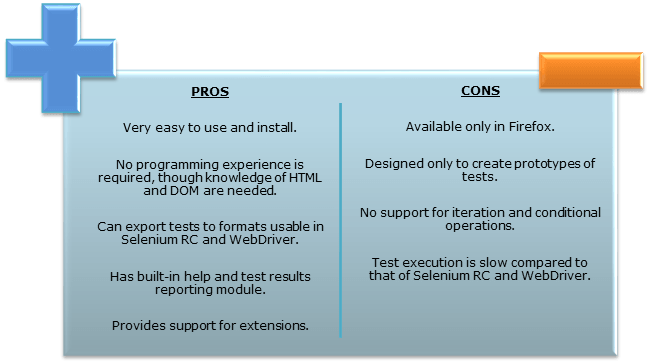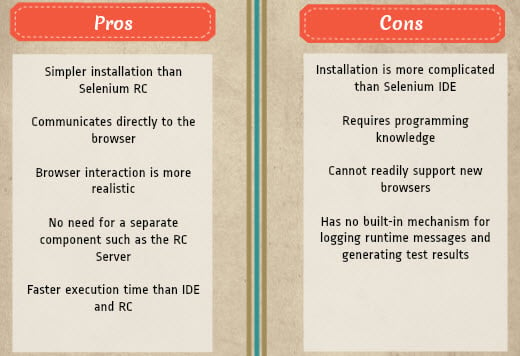Users Online
· Members Online: 0
· Total Members: 188
· Newest Member: meenachowdary055
Forum Threads
Latest Articles
Articles Hierarchy
Selenium Tutorial for Beginners:
What is Selenium? Introduction to Selenium Automation Testing
What is Selenium?
Selenium is a free (open source) automated testing suite for web applications across different browsers and platforms. It is quite similar to HP Quick Test Pro (QTP now UFT) only that Selenium focuses on automating web-based applications. Testing done using Selenium tool is usually referred as Selenium Testing.
Selenium is not just a single tool but a suite of software's, each catering to different testing needs of an organization. It has four components.
- Selenium Integrated Development Environment (IDE)
- Selenium Remote Control (RC)
- WebDriver
- Selenium Grid
- What is Selenium?
- Who developed Selenium?
- The Same Origin Policy Issue
- Birth of Selenium Remote Control (Selenium RC)
- Birth of Selenium Grid
- Birth of Selenium IDE
- Birth of WebDriver
- Birth of Selenium 2
- So, Why the Name Selenium?
- Brief Introduction Selenium IDE
- Brief Introduction Selenium Remote Control (Selenium RC)
- Brief Introduction WebDriver
- Selenium Grid
- Note on Browser and Environment Support
- How to Choose the Right Selenium Tool for Your Need
- A Comparison between Selenium and QTP(now UFT)
- Advantages of QTP over Selenium
At the moment, Selenium RC and WebDriver are merged into a single framework to form Selenium 2. Selenium 1, by the way, refers to Selenium RC.
Since Selenium is a collection of different tools, it had different developers as well. Below are the key persons who made notable contributions to the Selenium Project
|
Primarily, Selenium was created by Jason Huggins in 2004. An engineer at ThoughtWorks, he was working on a web application that required frequent testing. Having realized that the repetitious Manual Testing of their application was becoming more and more inefficient, he created a JavaScript program that would automatically control the browser's actions. He named this program as the "JavaScriptTestRunner." Seeing potential in this idea to help automate other web applications, he made JavaScriptRunner open-source which was later re-named as Selenium Core. |
The Same Origin Policy Issue
Same Origin policy prohibits JavaScript code from accessing elements from a domain that is different from where it was launched. Example, the HTML code in www.google.com uses a JavaScript program "randomScript.js". The same origin policy will only allow randomScript.js to access pages within google.com such as google.com/mail, google.com/login, or google.com/signup. However, it cannot access pages from different sites such as yahoo.com/search or guru99.com because they belong to different domains.
This is the reason why prior to Selenium RC, testers needed to install local copies of both Selenium Core (a JavaScript program) and the web server containing the web application being tested so they would belong to the same domain
Birth of Selenium Remote Control (Selenium RC)
Unfortunately; testers using Selenium Core had to install the whole application under test and the web server on their own local computers because of the restrictions imposed by the same origin policy. So another ThoughtWork's engineer, Paul Hammant, decided to create a server that will act as an HTTP proxy to "trick" the browser into believing that Selenium Core and the web application being tested come from the same domain. This system became known as the Selenium Remote Control or Selenium 1.
Birth of Selenium Grid
Selenium Grid was developed by Patrick Lightbody to address the need of minimizing test execution times as much as possible. He initially called the system "Hosted QA." It was capable of capturing browser screenshots during significant stages, and also of sending out Selenium commands to different machines simultaneously.
Birth of Selenium IDE
Shinya Kasatani of Japan created Selenium IDE, a Firefox extension that can automate the browser through a record-and-playback feature. He came up with this idea to further increase the speed in creating test cases. He donated Selenium IDE to the Selenium Project in 2006.
Birth of WebDriver
.jpg) Simon Stewart created WebDriver circa 2006 when browsers and web applications were becoming more powerful and more restrictive with JavaScript programs like Selenium Core. It was the first cross-platform testing framework that could control the browser from the OS level.
Simon Stewart created WebDriver circa 2006 when browsers and web applications were becoming more powerful and more restrictive with JavaScript programs like Selenium Core. It was the first cross-platform testing framework that could control the browser from the OS level.
Birth of Selenium 2
In 2008, the whole Selenium Team decided to merge WebDriver and Selenium RC to form a more powerful tool called Selenium 2, with WebDriver being the core. Currently, Selenium RC is still being developed but only in maintenance mode. Most of the Selenium Project's efforts are now focused on Selenium 2.
So, Why the Name Selenium?
It came from a joke which Jason cracked one time to his team. Another automated testing framework was popular during Selenium's development, and it was by the company called Mercury Interactive (yes, the company who originally made QTP before it was acquired by HP). Since Selenium is a well-known antidote for Mercury poisoning, Jason suggested that name. His teammates took it, and so that is how we got to call this framework up to the present.
Selenium Integrated Development Environment (IDE) is the simplest framework in the Selenium suite and is the easiest one to learn. It is a Firefox plugin that you can install as easily as you can with other plugins. However, because of its simplicity, Selenium IDE should only be used as a prototyping tool. If you want to create more advanced test cases, you will need to use either Selenium RC or WebDriver.
Brief Introduction Selenium Remote Control (Selenium RC)
Selenium RC was the flagship testing framework of the whole Selenium project for a long time. This is the first automated web testing tool that allowed users to use a programming language they prefer. As of version 2.25.0, RC can support the following programming languages:
- Java
- C#
- PHP
- Python
- Perl
- Ruby
Brief Introduction WebDriver
The WebDriver proves itself to be better than both Selenium IDE and Selenium RC in many aspects. It implements a more modern and stable approach in automating the browser's actions. WebDriver, unlike Selenium RC, does not rely on JavaScript for Automation. It controls the browser by directly communicating with it.
The supported languages are the same as those in Selenium RC.
- Java
- C#
- PHP
- Python
- Perl
- Ruby
Selenium Grid
Selenium Grid is a tool used together with Selenium RC to run parallel tests across different machines and different browsers all at the same time. Parallel execution means running multiple tests at once.
Features:
- Enables simultaneous running of tests in multiple browsers and environments.
- Saves time enormously.
- Utilizes the hub-and-nodes concept. The hub acts as a central source of Selenium commands to each node connected to it.
Because of their architectural differences, Selenium IDE, Selenium RC, and WebDriver support different sets of browsers and operating environments.
| Selenium IDE | WebDriver | |
|---|---|---|
| BrowserSupport | Mozilla Firefox | Internet Explorer versions 6 to 11, both 32 and 64-bit Microsoft Edge version 12.10240 & above ( partial support some functionalities under development) Firefox 3.0 and above Google Chrome 12.0. and above Opera 11.5 and above Android - 2.3 and above for phones and tablets (devices & emulators) iOS 3+ for phones (devices & emulators) and 3.2+ for tablets (devices & emulators) HtmlUnit 2.9 and above |
| Operating System | Windows,Mac OS X,Linux | All operating systems where the browsers above can run. |
Note: Selenium WebDriver is termed as the successor of Selenium RC which has been deprecated & officially announced by SeleniumHQ.
How to Choose the Right Selenium Tool for Your Need
| Tool | Why Choose? |
|---|---|
|
Selenium IDE |
|
|
Selenium RC |
|
|
WebDriver |
|
|
Selenium Grid |
|
Quick Test Professional(QTP) is a proprietary automated testing tool previously owned by the company Mercury Interactive before it was acquired by Hewlett-Packard in 2006. The Selenium Tool Suite has many advantages over QTP as detailed below -
Advantages of Selenium over QTP
| Selenium | QTP |
|---|---|
| Open source, free to use, and free of charge. | Commercial. |
| Highly extensible | Limited add-ons |
| Can run tests across different browsers | Can only run tests in Firefox, Internet Explorer and Chrome |
| Supports various operating systems | Can only be used in Windows |
| Supports mobile devices | QTP Supports Mobile app test automation (iOS & Android) using HP solution called - HP Mobile Center |
| Can execute tests while the browser is minimized | Needs to have the application under test to be visible on the desktop |
| Can execute tests in parallel. | Can only execute in parallel but using Quality Center which is again a paid product. |
Advantages of QTP over Selenium
| QTP | Selenium |
|---|---|
| Can test both web and desktop applications | Can only test web applications |
| Comes with a built-in object repository | Has no built-in object repository |
| Automates faster than Selenium because it is a fully featured IDE. | Automates at a slower rate because it does not have a native IDE and only third party IDE can be used for development |
| Data-driven testing is easier to perform because it has built-in global and local data tables. | Data-driven testing is more cumbersome since you have to rely on the programming language's capabilities for setting values for your test data |
| Can access controls within the browser(such as the Favorites bar, Address bar, Back and Forward buttons, etc.) | Cannot access elements outside of the web application under test |
| Provides professional customer support | No official user support is being offered. |
| Has native capability to export test data into external formats | Has no native capability to export runtime data onto external formats |
| Parameterization Support is built | Parameterization can be done via programming but is difficult to implement. |
| Test Reports are generated automatically | No native support to generate test /bug reports. |
Though clearly, QTP has more advanced capabilities, Selenium outweighs QTP in three main areas:
- Cost(because Selenium is completely free)
- Flexibility(because of a number of programming languages, browsers, and platforms it can support)
- Parallel testing(something that QTP is capable of but only with use of Quality Center)
Summary
- The entire Selenium Tool Suite is comprised of four components:
- Selenium IDE, a Firefox add-on that you can only use in creating relatively simple test cases and test suites.
- Selenium Remote Control, also known as Selenium 1, which is the first Selenium tool that allowed users to use programming languages in creating complex tests.
- WebDriver, the newer breakthrough that allows your test scripts to communicate directly to the browser, thereby controlling it from the OS level.
- Selenium Grid is also a tool that is used with Selenium RC to execute parallel tests across different browsers and operating systems.
- Selenium RC and WebDriver was merged to form Selenium 2.
- Selenium is more advantageous than QTP in terms of costs and flexibility. It also allows you to run tests in parallel, unlike in QTP where you are only allowed to run tests sequentially.




.png)
.jpg)
.jpg)




